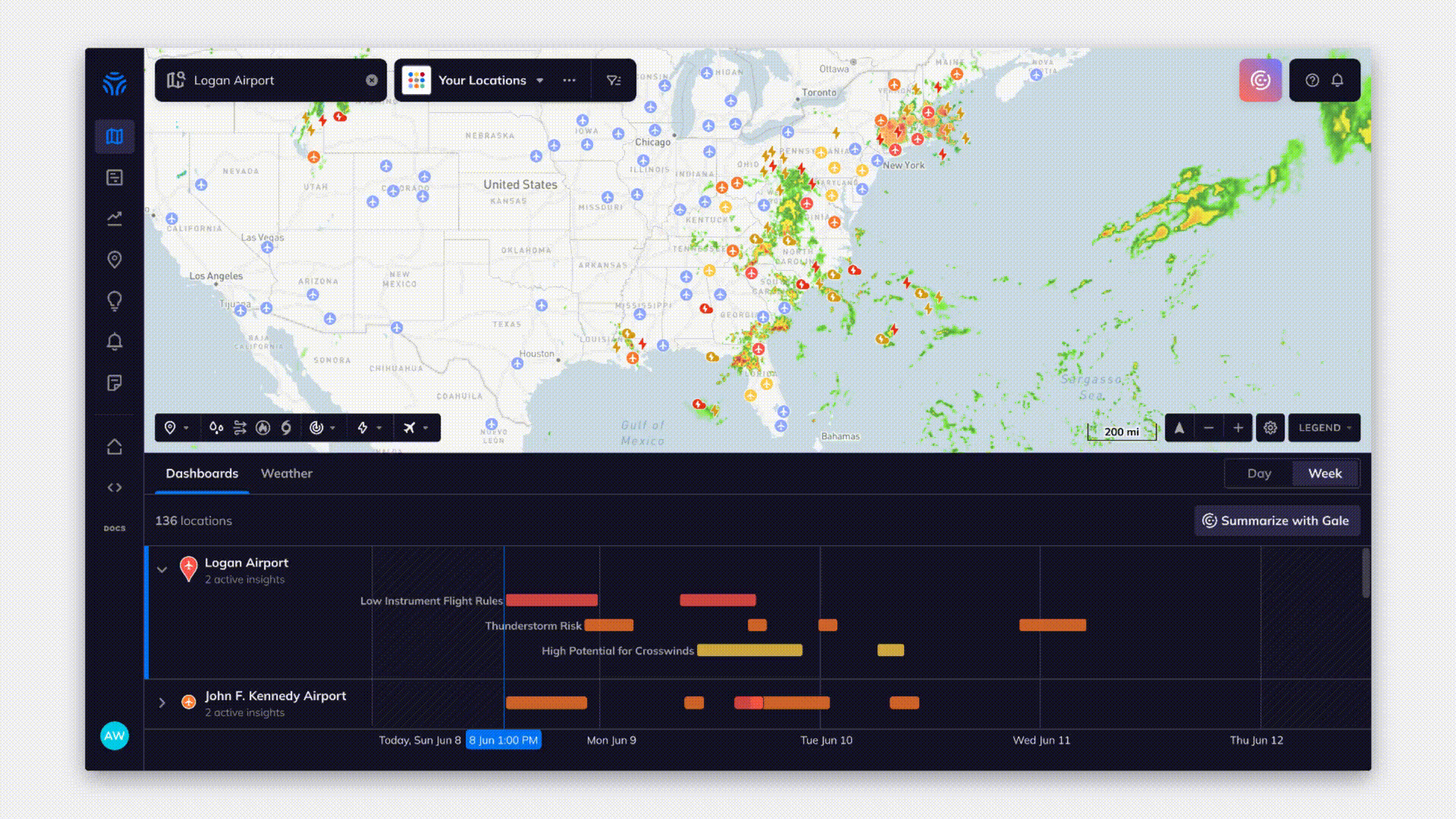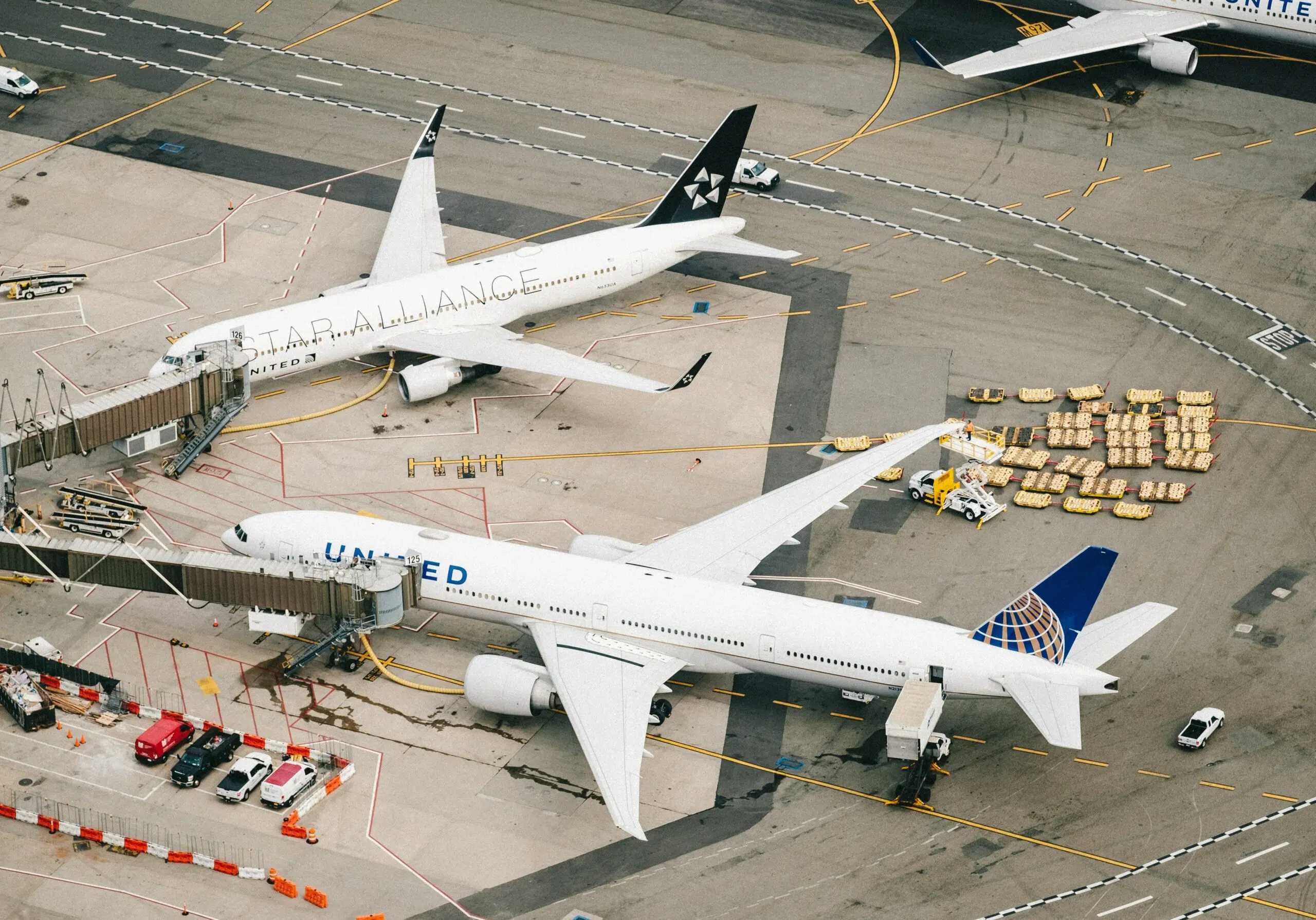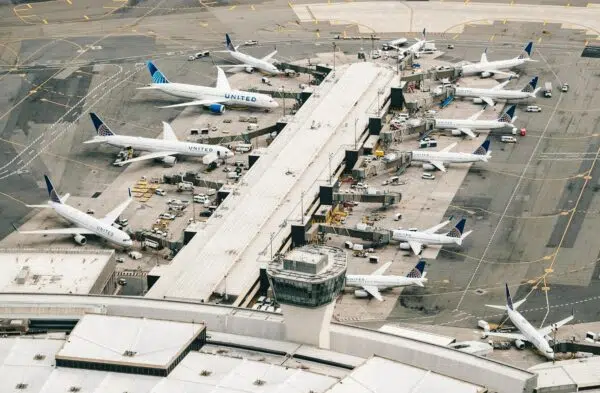The aviation industry faces numerous challenges due to constantly changing weather conditions. Between 2017 and 2022, the FAA reported that weather was responsible for nearly 75% of flight delays due to severe conditions.
With the emergence of new tech, we are now seeing the application of weather AI to improve operations within various industries, including aviation.
This blog will cover:
- What is weather AI for aviation?
- How does weather AI for aviation work?
- The impact of weather and climate on aviation
- The benefits of using AI tools in the aviation industry
Understanding how AI can adaptively provide weather-related insights will serve stakeholders well within the industry ─ airlines, including JetBlue and Azul Linhas Aéreas Brasileiras, are already seeing improvements in adjusting to changing weather conditions.
The Impact of Weather on Aviation
Weather plays a crucial role in the aviation industry, impacting flight safety, efficiency, and overall passenger experience. Unfavorable weather conditions can lead to delays, diversions, and even cancellations of flights.
With nearly 75% of flights delayed due to weather, it’s paramount for airlines and airports to have accurate and reliable weather information at their disposal. “Weather impacts nearly every aspect of aviation operations,” says Mark Pahl, Director of Aviation Sales, at Tomorrow.io, “Ground crews, dispatchers, flight planners, pilots and flight attendants are impacted by freezing temperatures, high winds, lightning, runway crosswinds, snow, frost, tropical storms, precipitation, low visibility and many other weather conditions. These weather conditions impact not only flight schedules and on-time operations, but they can also impact passenger and crew safety, which is always an airline’s number one priority.”
While airlines can’t do anything to change the weather, there is a lot they can do to be adequately prepared to minimize the impact that weather has on their operations.
Weather AI is here to support this. Here’s how weather impacts the aviation industry.
Flight Safety Concerns
Weather compromises flight safety. Severe turbulence caused by thunderstorms or turbulent atmospheric phenomena can lead to injuries among passengers and crew members. Additionally, low-visibility situations like fog, heavy rain, or snowfall present further complications for pilots. With such circumstances posing risks during takeoff and landing operations, weather technology for improved decision-making is crucial for ensuring passenger welfare.
Implications on Efficiency
Hazardous weather conditions also have implications on operational efficiency. Unexpected rerouting and cancellations due to severe weather or airspace closures (imposed by authorities following natural events) directly impede these efforts by causing time-consuming diversions or layovers, which increase fuel consumption rates and directly affect employees and travelers.
Did you know? Inclement weather delays translate into actual costs for airlines and the public. The FAA reports that the cost to an airline for an hour of delay ranges from $1,400 to $4,500, with the value of passenger time ranging from $35-$63 per hour.
This elevated financial implication requires better solutions to operate around these delays.
Passenger Experience Challenges
Unpredictable weather also negatively impacts the overall customer experience. Passengers enduring delayed flights lead to missed connections or possible cancellations, ultimately influencing satisfaction levels and brand perception. In 2022, a notable airline suffered operational challenges due to winter weather leading to 70% of flights being canceled and disrupting holiday travel in the U.S.
Airlines must employ efficient communication channels while managing expectations effectively upon unforeseen surprises unfolding during routine schedules easing traveler anxieties.
By recognizing the significant impact of weather on airline operations, the aviation industry has turned to more sophisticated solutions such as weather AI. The goal is to make better-informed decisions based on enhanced predictions and assessments of weather events. Improved decision-making saves time and money for airlines.
JetBlue’s Steven Olson, VP of Systems Operations, speaks to the power of weather intelligence and AI when he says, “The rate in which we have canceled flights, the rate in which we’ve delayed flights associated with weather has improved remarkably just in one year’s time frame. [Tomorrow.io] is already saving [JetBlue] $300,000 every month, $3.7 million in a year.”
By implementing artificial intelligence, airlines aim to alleviate some pressure points they traditionally face.
What is Weather AI for Aviation?
Weather AI, or Artificial Intelligence for weather forecasting for aviation, uses artificial intelligence to improve weather forecasting, prediction, output, and insight delivery for the aviation industry. Weather AI is a powerful tool designed to enhance aviation operations by providing more accurate and timely forecasts of complex weather patterns. These forecasts provide decision-making support for airline operations.
By harnessing the computational prowess of machine learning algorithms and large-scale data processing capabilities, advanced systems can analyze various atmospheric variables to generate highly detailed weather forecasts explicitly tailored for aviation needs.
Several aspects differentiate Weather AI from traditional weather prediction methods:
- Data-Driven Approach: AI-based weather forecasting relies on analyzing historical climate records, real-time atmospheric observations such as wind speeds, outdoor temperature, and altitude, and relevant aviation-specific information to recognize distinct patterns associated with different weather phenomena.
- Machine Learning Technology: Weather AI leverages sophisticated machine learning models like neural networks and deep learning techniques to continuously learn from new data inputs and refine their predictive abilities over time.
- High-Resolution Modeling: Unlike conventional numerical models that handle moderate spatial scales, Weather AI can microscale meteorological processes at finer resolutions—enabling sharper insights into localized events such as microbursts or runway conditions during adverse weather conditions.
- Adaptive Forecasts: Weather AI dynamically tailors its output considering various parameters specific to each flight route – altitude, speed, onboard systems – ensuring that the selected predictions remain relevant amidst constantly changing flight scenarios.
The ultimate goal of incorporating artificial intelligence into meteorology for aviation purposes is to enhance safety procedures, improve operational efficiency and minimize environmental impacts.
Air traffic controllers may no longer struggle with limited storm data or congested flight areas. Thanks to AI, they can now detect even small weather changes that impact flights, leading to better airspace management based on advanced, data-driven decisions.
Tools to Improve Aviation Operations
But where can you find a tool that supports each of these areas? Weather intelligence and weather AI tools from leaders like Tomorrow.io are innovators in this space.
Weather Intelligence from Tomorrow.io
Tomorrow.io, the world’s leading weather intelligence and climate adaptation platform, has been hard at work, integrating AI capabilities into their weather intelligence platform and releasing Gale, the world’s first weather and climate generative AI, working to solve some of these looming issues in aviation and beyond

Weather intelligence ensures safe and efficient aviation operations. It is a technology and data-backed process that allows businesses to focus on their operational needs. Rather than seeing that tomorrow’s temperature will be 75 degrees Fahrenheit, weather intelligence provides you with the insights needed to operate around that.
Tomorrow.io utilizes sophisticated machine learning algorithms, AI, and proprietary upcoming next-generation weather data from their first two Pathfinder satellites. This combination focuses on accuracy and timeliness by providing hyperlocal near-real-time weather forecasts and AI-created weather insights to support your operations.
By leveraging artificial intelligence (AI) to improve aviation with weather technology, airlines can better manage flight planning, routing, and airport operations. This section will explore how AI-based weather forecasting can significantly support the aviation industry’s diverse needs.
Tomorrow.io’s aviation solution serves as a vital assistant in navigating numerous weather-related challenges by improving the following.
Flight Planning and Routing
Flight planning is an essential component of any successful airline operation. Using AI-powered weather technology, Tomorrow.io provides airlines with accurate forecasts and predictions on conditions like wind patterns and lightning potential that could cause turbulence and other flight disruptions. This process enables leaders in aviation operations to make informed decisions on optimal flight paths that maximize both safety and fuel efficiency. Incorporating real-time data updates further allows airlines to be agile in adapting their routes as needed and minimizing disruptions or delays caused by sudden atmospheric changes.
Demand Forecasting and Schedule Management
Airlines continuously strive for cost-effective management strategies that satisfy customer demands without sacrificing profitability. Utilizing AI-based weather solutions helps predict variations in weather patterns affecting air travel demands & preferences; it can also support decisions regarding scheduling aircraft maintenance works accordingly.
Here are some ways historical weather patterns, past flight information, and weather AI can improve schedule management:
- Identify peak periods when high passenger turnout is expected.
- Make informed decisions on cancellations or route adjustments during severe weather events.
- Preemptively minimize delays from disruptive meteorological phenomena such as gusty winds or thunderstorms.
Airport Ground Operations Efficiency & Safety
Effective airport ground operations hinge on accurate, timely weather data. With AI-powered weather insights, management teams benefit from a more comprehensive understanding of current climatic conditions, allowing them to plan ground operations such as refueling, catering provision, baggage handling, and aircraft engineering efficiently & safely.
Advanced warning of adverse weather occurrences ensures the safety of both passengers and ground crews by providing ample time to execute contingency plans or suspend activities that might pose a risk during unfavorable weather events.
The Benefits of Weather AI for the Aviation Industry
The integration of weather AI within the aviation industry opens up numerous possibilities to improve operations and bring about dramatic changes in multiple areas. This section will break down those possibilities.
Enhanced Safety
Safety is the top priority in aviation; whether it’s keeping passengers or crews safe, there are still many things we can improve in how we do it. AI can support these changes by:
- Providing accurate and real-time weather information. Making crucial decisions on flight routes or delays becomes easier with precise data generated by weather AI.
- Predicting severe weather events: Advanced algorithms can foresee storms, turbulence, and other hazardous conditions with remarkable accuracy, enabling proactive risk mitigation measures.
- Supporting more efficient air traffic management: By incorporating detailed forecasts from AI-driven models, air traffic controllers can optimize flight paths for minimal disruption due to adverse weather conditions.
Airlines can stay one step ahead of potential dangers caused by unforeseen high-impact weather and utilize extra protection for passengers and crew members alike.
Improved Efficiency
In addition to enhancing safety levels, implementing weather AI in aviation paves the way for increased efficiency across various operational aspects.
- Optimized flight planning: Utilizing accurate forecasts helps pilots and airline managers select the best possible routes and altitudes to avoid severe disturbances, ultimately saving fuel and maintenance costs.
- Improving maintenance procedures: de-icing planes is a critical yet expensive and often inefficient process. AI helps decrease delays, save on fuel and de-icing fluid by optimizing taxi/block time for de-icing procedures.
- More intelligent fleet allocation: Weather anticipation through advanced models enables better aircraft rotation management among destinations while considering atmospheric factors.
- Faster recovery from disruptions: Accurate predictions facilitate quick response time against incidents like sudden closures due to snowstorms—enabling airlines to reroute flights or deploy alternative resources more effectively.
Recognizing these advantages makes it clear how critical investing and leveraging AI-powered weather analysis tools is for streamlining airline operations.
Better Customer Experience
Passenger satisfaction plays a significant role in determining an airline’s success. Integrating weather AI allows for improvements that translate into tangible benefits to the customer by:
- Minimizing flight delays and cancellations: Timely insights from AI models can help airlines manage schedules proactively and make well-informed decisions about potential disruptions.
- Ensuring smoother, more comfortable flights: By avoiding turbulent areas through better route planning, passengers enjoy a less stressful journey with fewer unexpected interruptions.
- Enhanced communication: Sharing accurate weather data with customers keeps them informed on changes or potential issues, thus improving transparency and trust.
Aviation companies can foster long-term customer loyalty and positive reputation growth by emphasizing utilizing advanced artificial intelligence resources to elevate client experience levels.
Reduced Environmental Impact
Lastly, employing weather AI in the aviation industry offers substantial environmental benefits:
- Fuel conservation: Accurate forecasts enable airlines to adapt flight paths during real-time conditions, reducing fuel consumption due to shorter travel distances or bypassing turbulence.
- Decreased noise pollution: Tailored flight routes diminish the exposure of communities near airports to excessive noise by reducing the need for excessive engine thrust during adverse meteo situations.
- Lower carbon emissions: As fuel consumption decreases, airlines produce significantly fewer greenhouse gas emissions—an essential aspect of working concertedly against climate change impacts.
Incorporating cutting-edge technology proves vital for the evolution towards greener aviation practices that comply with regulatory standards and protect our planet while providing first-rate services within the sector.
What is the Future of AI in the Airline Industry?
As we venture into the future, artificial intelligence will continue transforming the aviation industry, unlocking unprecedented potential and revolutionizing various aspects of airline operations. Leveraging advanced analytics and machine learning models, airlines can improve aviation with weather AI and fundamentally reshape their approaches to safety, efficiency, sustainability, and customer experience management. Let’s explore several promising trends that will shape the future of AI in airline operations.
- Predictive Analytics: AI will power more advanced weather predictions, enabling airlines to preemptively adjust to adverse conditions, from flight routing to passenger rebooking and maintenance rescheduling.
- Hyper-Personalized Customer Experience: AI could eventually use large data sets, like social media interactions and loyalty program information, to provide passengers with tailored experiences, such as personalized route suggestions, targeted inflight services, and real-time delay predictions.
- Streamlined Collaboration: AI could improve cooperation between airlines and air traffic management authorities, reducing inefficiencies caused by inconsistent information circulation.
- Green Aviation and Sustainable Solutions: AI is essential to the aviation industry’s sustainability goals, with potential contributions in fuel efficiency optimization, emission reduction through alternate routing, and facilitating renewable energy innovation and integration.
Conclusion
The game-changing tool the aviation industry has been waiting for is here with Weather AI. This technology redefines efficiency and elevates flight safety for employees and passengers. With precise near real-time weather forecasts, the ability to leverage historical weather data, and upcoming satellite precipitation data, Tomorrow.io is positioned to help businesses reduce costs, optimize efficiency, and keep passengers happy.
Learn more about how AI is changing the aviation industry.
Weather AI for Aviation FAQ
As you explore the potential of using artificial intelligence to improve aviation with weather AI, you might have questions about its implementation and benefits. This section will address some of the most frequently asked questions about weather AI within the aviation industry. By understanding these aspects, you can make informed decisions on improving airline operations and overall efficiency.
How Does AI Improve Weather Forecasting?
AI can process vast amounts of data quickly and accurately, making it an excellent tool for enhancing weather forecasts. AI-powered forecasting systems can generate precise predictions that benefit airlines by analyzing historical weather patterns, real-time atmospheric conditions, satellite imagery, and other relevant information. Machine learning algorithms continuously refine Tomorrow.io’s Comprehensive Bespoke Atmospheric Model (CBAM) and unified precipitation models based on new data input, allowing them to produce more accurate forecasts over time than standard models. This process is also in comparison to re-packaged weather data from the NWS.
Why Is Meteorology Important for Aviation?
Meteorology plays a crucial role in the safe and efficient operation of airlines and is vital to aviation because of the severe impacts it can have. Weather not only affects flight routes but also impacts airport functioning (e.g., ground activities), aircraft performance (e.g., de-icing procedures), crew schedules (factoring in factors such as jet lag), fuel consumption (considering headwinds/tailwinds), passenger comfort (by avoiding turbulence when possible), and air traffic management. By providing accurate weather information, meteorology allows airlines to make informed decisions and mitigate risks associated with adverse conditions.









